Just a few hours upstream of Portland’s concentration of marinas on Hayden Island lies spectacular scenery and new sections of the Columbia to explore. But many boaters are hesitant to make the journey. They are reluctant because they have never taken their boat through locks or they fear commercial traffic offers an obstacle they would rather not navigate. With a little planning and preparation, it's easy to navigate the locks and gain access to some of the best boating in the Pacific Northwest.
A Short Trip Up the river Reveals Spectacular Scenery
The Columbia River Gorge is known as one of the most scenic drives in North America— it’ even better by boat. Portland is an ideal jumping off point for exploring the beauty of the Gorge. Just 14 miles upstream from Portland, the river narrows creating a beautiful gorge packed with waterfalls, cliffs and unique geological formations. The town of Cascade Locks offers a marina to dock and explore dining, shopping and historical exhibits. The trip can be done in a weekend or as a stepping stone to exploring points further upstream on the Columbia.
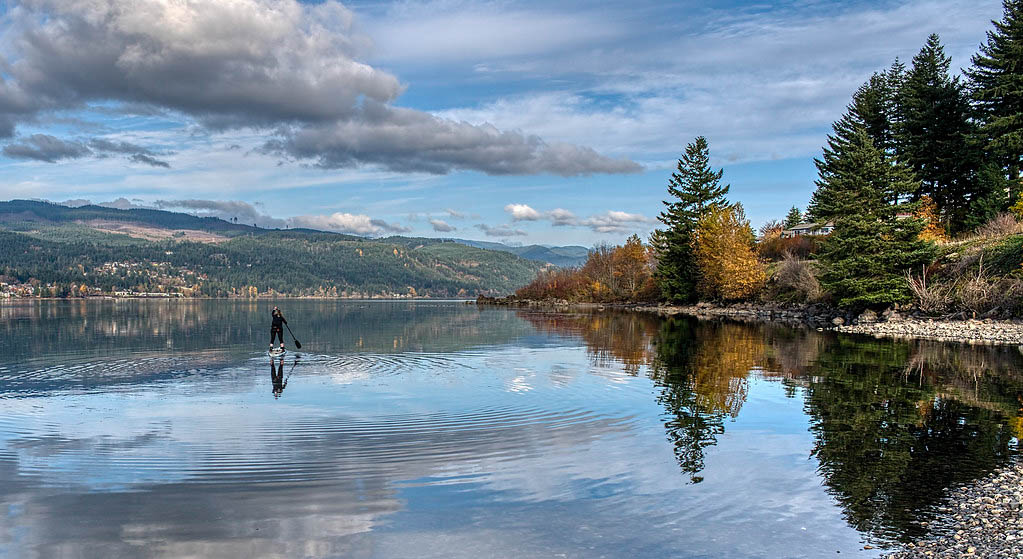
Good To Know – Going Through the Locks
To get to Cascade Locks means going through the Bonneville locks. The trip will add a new element to boating
and will open up the Columbia River to even more scenic sections. Preparation is the key to making the trip as
smooth as possible.
Basic Steps
1. Contact the dam master to schedule lockage
2. Prep the boat with lines and fenders
3. Motor/Anchor until lock operators instruct you enter the lock
4. Enter and Exit the lock when instructed by lock operators
5. Keep clear of larger commercial vessels as you navigate away from the lock
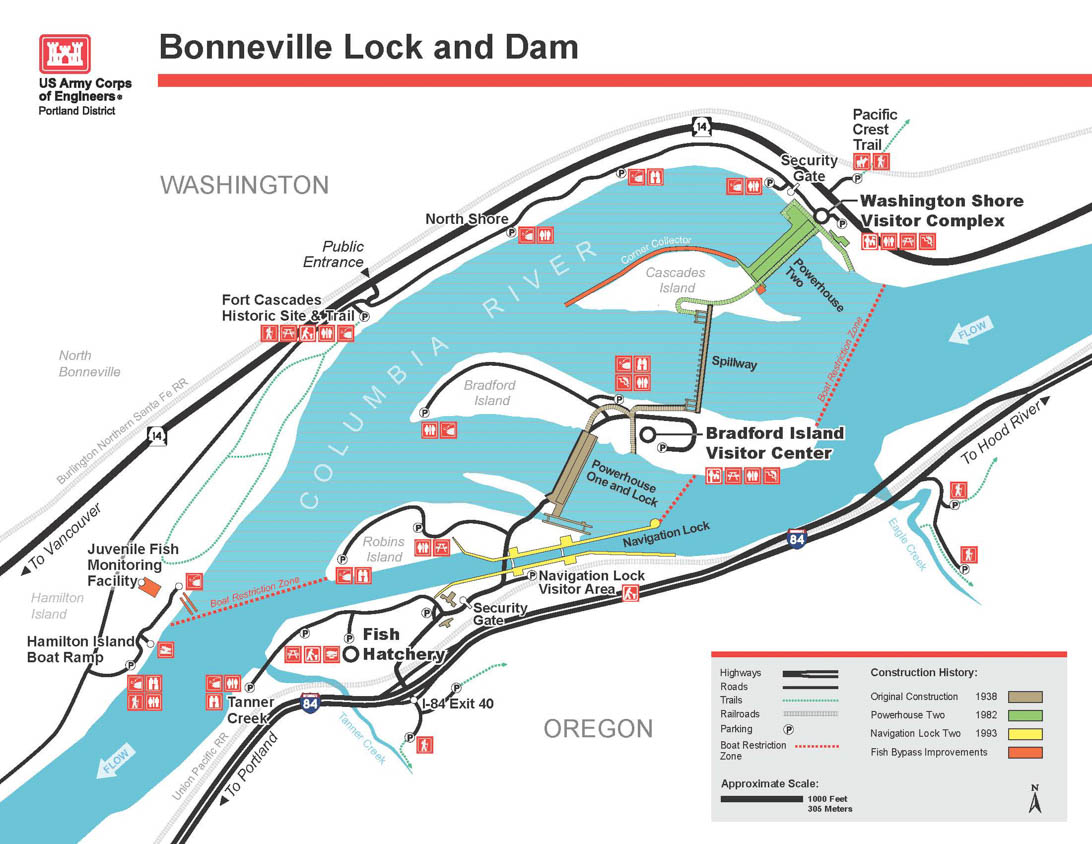
The first step is to contact the Dam Master to schedule lockage. This can be easily done by hailing the dam on VHF channel 14. The official call sign for the Bonneville Dam is WUJ 33, but the Dam Master will also respond to “Bonneville Dam Master”. While a VHF is preferred, you can use a mobile phone to call the Bonneville Dam (541) 374-8323) to speak to lock operator to arrange lockage. You will be given a time (usually a rough estimate) to enter the locks. During peak season the lock sticks to a daily schedule for upstream and downstream traffic (see below). Outside of peak season the lock is operated on a first come first serve basis with an eye for water conservation; meaning you may have to wait depending on the water level within the lock. You will be asked some questions regarding your boat to help the operator organize the boating traffic and to determine whether or not the swing bridge must be opened to allow access. Most power vessels will easily clear the bridge under most water levels; sailboats will have to check with lock operator for current clearance.
While waiting to enter the lock is a good time to prep the boat. This can be done in route, at a staging float at the lock’s downstream entrance or better yet, from the protected moorage of Beacon Rock (5 miles downstream on the Washington side). There are no staging docks available on the upstream side of the locks. Get out available fenders making sure they are properly inflated. Set up dock lines at the bow and stern on both sides of the boat—you may tie up to port or starboard or even raft up to other boats depending on traffic. You will tie up to one of eight floating mooring bitts (recessed cleats) in lock’s walls; it is important to make sure that all equipment is secured within your boat’s beam. That is to say outriggers, antennas and other gear that normally hangs beyond the shear is stowed and will not come in contact with the walls of the lock. Prepare fenders to be deployed on port and/or starboard sides. The lock wall remains stationary during the filling and spilling of the lock, your fenders will be dragged along the surface of the walls. It is a good idea to remove any protective covers that may be torn by the abrasion.
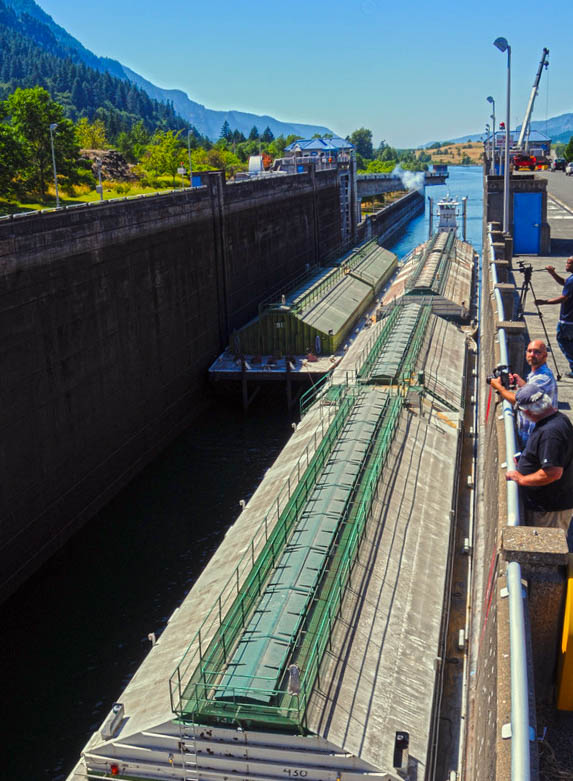
Bonneville Lock can hold up to 6 barges and a tug. Image © U.S. Army Corps of Engineers
As you approach the dam from the downstream be prepared for a some current. The current is most effected by the release of water from the overflow section of the dam. Rain, snow-melt and (to a much less degree) power demands can produce strong currents. The lock entrance is clearly marked with signs and is located between Robins Island and the Oregon Shore – boats are not permitted upstream of the island.
Once you’ve entered the narrows toward the lock, the current should calm significantly and navigation will become much easier. Be aware of any vessels exiting the lock and stay clear of commercial traffic (i.e. barges) that transport grains and fuel up and down the river.
On the upstream side of the locks the entrance is close the Oregon shore opposite the Sternwheeler dock on Bradford Island. The navigation challenge on the upstream side will be wind. The bulk of the summer days will see 10 mph winds, but 15-20 mph winds are not unheard of. Winds begin to build around 10:00 am and wain around 7:00 pm and are typically WSW. The peak wind occurs between 2:00pm- 3:00pm. Give yourself extra space to maneuver and take advantage of the fenders you have ready.
A red and green traffic light will be the indicator to give you go-ahead enter the lock—they may also be some guidance over the VHF or intercom. When it’s your time, the Dam Master will guide you into the lock and provide instructions where to tie-up. Secure your lines to the floating mooring bitts and position fenders as needed. The lock gates will close and the lock will begin to fill at a rate of about 1”/second. The transition from downstream to upstream or vice-versa should take about 20 minutes.
As you exit the locks navigate clear of boats waiting to enter the locks being especially mindful of barges and tugs – remember your boat is much more maneuverable.
Bonneville Dam
The Bonneville dam is a Public Works Administration project created by President Roosevelt’s New Deal and was completed in 1938. In 1987 it was declared a National Historic Landmark. Prior to the Bonneville lock, river traffic navigated through a system of locks built to allow boats to pass through a stretch of rapids that would challenge whitewater rafters. Many vessels were destroyed trying to navigate this section of the river before the locks. The Public Works Administration also has a hydropower element that supplies electricity to the Pacific Northwest. Both the hydropower generators and the lock are operated by the Army Corps of Engineers and have been improved over the years to accommodate growing needs; a second powerhouse was added in 1981 and the navigation lock was enlarged in 1993. A visitor center welcomes guest to the dam year-round. The lock has its own visitor center that is open between Memorial Day and Labor Day. During the open season, you can check out the locks by car before venturing through by boat. Unfortunately, there are no docks to tie-up to access the visitor center by boat.
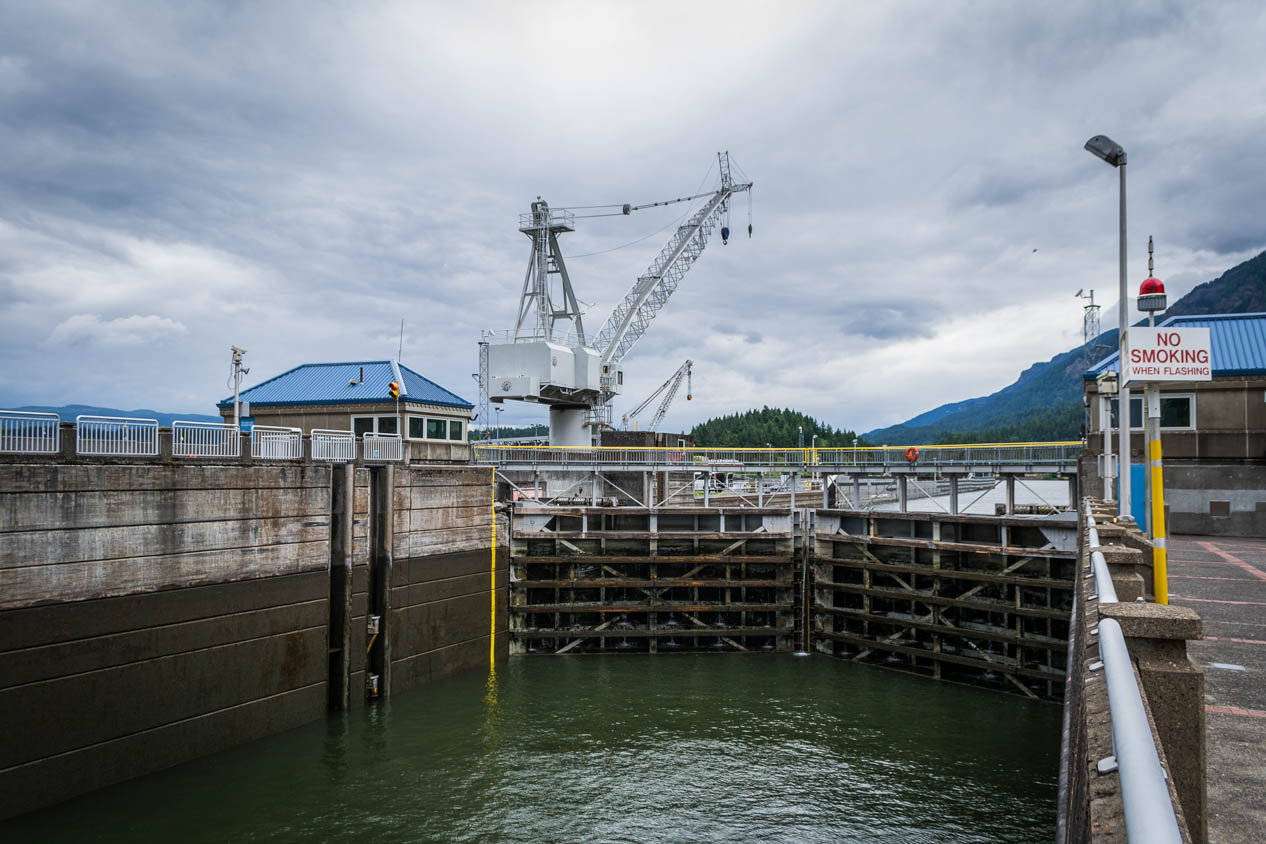
Bonneville Lock can hold up to 6 barges and a tug. Image © U.S. Army Corps of Engineers
As you approach the dam from the downstream be prepared for a some current. The current is most effected by the release of water from the overflow section of the dam. Rain, snow-melt and (to a much less degree) power demands can produce strong currents. The lock entrance is clearly marked with signs and is located between Robins Island and the Oregon Shore – boats are not permitted upstream of the island.
Once you’ve entered the narrows toward the lock, the current should calm significantly and navigation will become much easier. Be aware of any vessels exiting the lock and stay clear of commercial traffic (i.e. barges) that transport grains and fuel up and down the river.
On the upstream side of the locks the entrance is close the Oregon shore opposite the Sternwheeler dock on Bradford Island. The navigation challenge on the upstream side will be wind. The bulk of the summer days will see 10 mph winds, but 15-20 mph winds are not unheard of. Winds begin to build around 10:00 am and wain around 7:00 pm and are typically WSW. The peak wind occurs between 2:00pm- 3:00pm. Give yourself extra space to maneuver and take advantage of the fenders you have ready.
A red and green traffic light will be the indicator to give you go-ahead enter the lock—they may also be some guidance over the VHF or intercom. When it’s your time, the Dam Master will guide you into the lock and provide instructions where to tie-up. Secure your lines to the floating mooring bitts and position fenders as needed. The lock gates will close and the lock will begin to fill at a rate of about 1”/second. The transition from downstream to upstream or vice-versa should take about 20 minutes.
As you exit the locks navigate clear of boats waiting to enter the locks being especially mindful of barges and tugs – remember your boat is much more maneuverable.
Bonneville Dam
The Bonneville dam is a Public Works Administration project created by President Roosevelt’s New Deal and was completed in 1938. In 1987 it was declared a National Historic Landmark. Prior to the Bonneville lock, river traffic navigated through a system of locks built to allow boats to pass through a stretch of rapids that would challenge whitewater rafters. Many vessels were destroyed trying to navigate this section of the river before the locks. The Public Works Administration also has a hydropower element that supplies electricity to the Pacific Northwest. Both the hydropower generators and the lock are operated by the Army Corps of Engineers and have been improved over the years to accommodate growing needs; a second powerhouse was added in 1981 and the navigation lock was enlarged in 1993. A visitor center welcomes guest to the dam year-round. The lock has its own visitor center that is open between Memorial Day and Labor Day. During the open season, you can check out the locks by car before venturing through by boat. Unfortunately, there are no docks to tie-up to access the visitor center by boat.
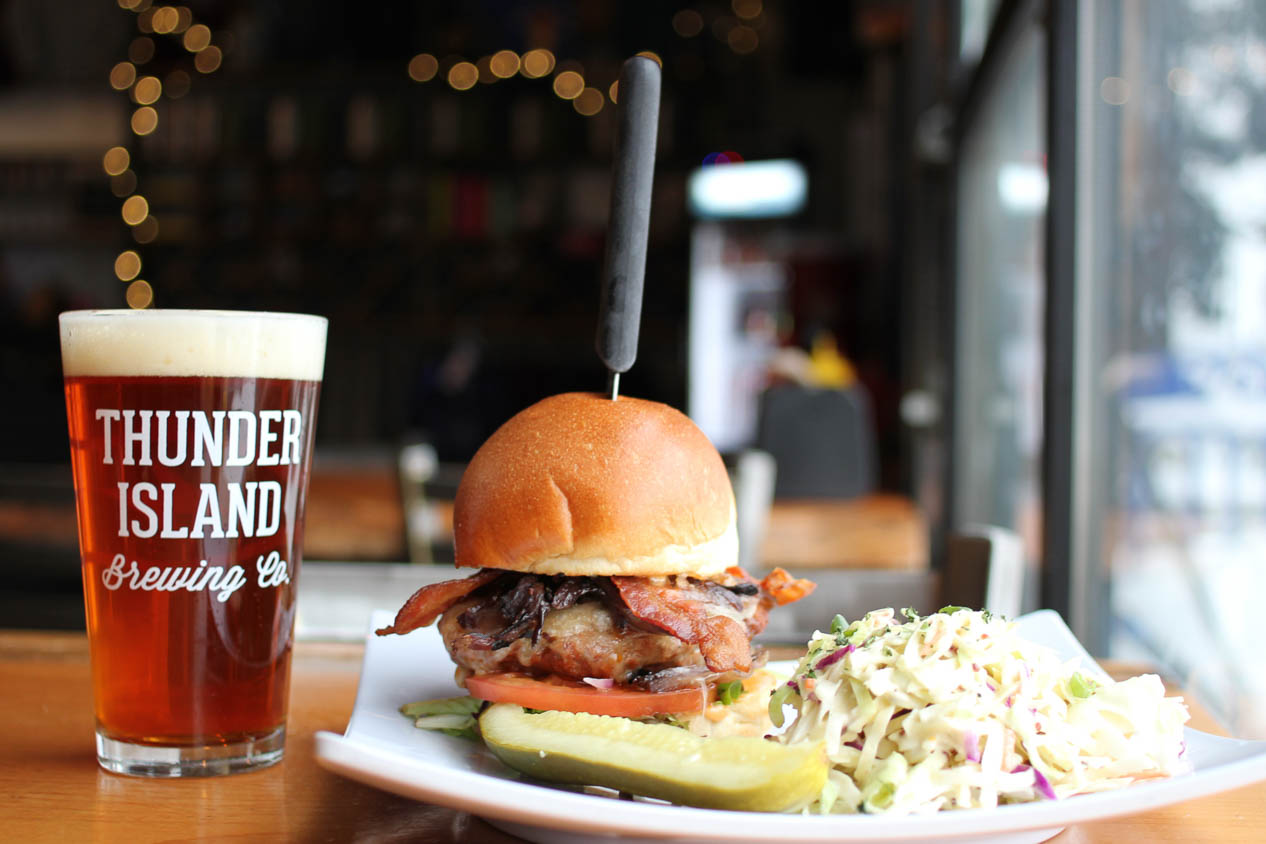
Thunder Island Brewing Co.
Local Knowledge
- The lock operators wear several hats and have to perform different tasks at the Bonneville facility. Outside of the peak season there may be a slight delay while the operator returns to the locks from another part of the dam.
- Winds pick up in the afternoon; boats with large freeboard will enjoy the calmer breezes of the morning (more of an issue on the upstream side of the locks)
- Weather Info: The local Hood River, KCGB (105.5 FM) offers a recreational weather report with wind information around 10 minutes before the hour between 6:00 am and 10:00 am to give you an idea what to expect. This recreation report runs from the middle of April until the end of September. You can also receive constant weather information from the NOAA WX station WXM34—162.400MHz.
- Emergency Staging Dock is only available on the downstream side of the locks—there is no dock on the upstream side.
Local Events
There are numerous sailing events held in Cascade Locks throughout the summer months—July and August feature the most. Organizers set the race course close to shore to make it better for spectators. Many of the region’s best sailors compete on high-speed dinghies making these events exciting to watch—even for non-sailors.
- Once a month there is an open-air movie in Marina Park. Grab a lawn chair (and maybe a blanket) and catch a family friendly show with the beauty of the Gorge as a backdrop.
- There are running races in August and September
- The Sternwheeler Cruises depart from the Marine Park if you want to get out on the water with someone else at the helm.
- The visitor center at Bonneville Dam provides a behind the scenes look at one of the Pacific Northwest’s biggest power plants, but can only be accessed from the highway—there are no docks to access the visitor centers.
- Marine Park is a great place to stretch your sea-legs and has picnic tables, restrooms, and other facilities.
- A museum showcasing the history of the Cascade Locks is volunteer-operated and open 12:00-5:00pm May-Sept (closed Monday except holidays)